Panna, Madhya Pradesh
“July is about to end, but where is the rain?”
With a marked anxiety in his voice, Malkhan Singh Gaud, a 55-year-old farmer from Madhya Pradesh’s Panna district pointed towards his drying seedlings of paddy spread across an acre [almost half an hectare] of land.
“If it doesn’t rain in the coming three-four days, my entire paddy crop will fail. The tiny seedlings have already turned yellowish. It’s not a good sign,” Gaud, an adivasi farmer from Panna’s Bilha village told Gaon Connection. “I don’t have the facility to irrigate my field from a well or a tubewell. I will have no source of livelihood if my paddy crop fails,” the worried farmer added.
Unlike Gaud, his neighbour Sonelal Patel has an old well near his field from which he daily fetches thousands of litres of water to keep his paddy saplings from drying off.
“I have planted paddy in dedh (1.5) acre of land. Half of the seedlings have already dried off. The other half I have somehow kept alive by supplying water from my well. But it cannot go on for long. Farmers like me are desperately waiting for the rains,” Patel told Gaon Connection.
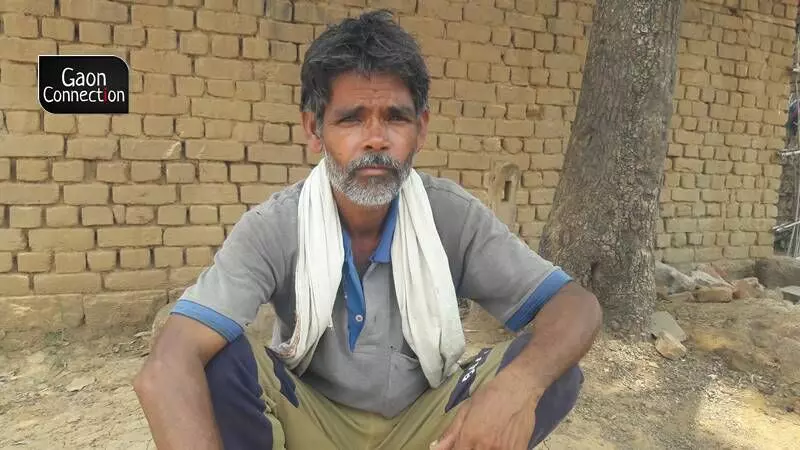
Unlike Gaud, his neighbour Sonelal Patel has an old well near his field from which he daily fetches thousands of litres of water to keep his paddy saplings from drying off.
If rains fail, hundreds of thousands of farmers from Bundelkhand, such as Goud and Patel, will have to migrate to distant cities and live far away from their families to earn a living. For now, they are gazing at the sky and worrying about their drying paddy nurseries.
“There’s little possibility that I’ll find labour work within or around my village. Farmers in this area migrate to far off cities when they are unable to harvest a crop which can sustain them throughout the year,” Gaud trailed off.
“I never wanted to work as a labourer far away from my family but if it doesn’t rain soon, many farmers like me will have to migrate,” Ramesh Yadav, a 40-year-old farmer from Amokhar village in Rewa district, told Gaon Connection.
Drought in sight?
Panna district falls under Bundelkhand — a plateau region which is spread over about 69,000 square kilometres of land in seven districts of Uttar Pradesh (Chitrakut, Banda, Jhansi, Jalaun, Hamirpur, Mahoba and Lalitpur) and six districts of Madhya Pradesh (Chhatarpur, Tikamgarh, Damoh, Sagar, Datia and Panna).
Gaon Connection recently reported that while large parts of the country, from Assam in northeast to Rajasthan and Gujarat in western India, and several states in peninsular India are facing floods due to extremely heavy rainfall, farmers in Uttar Pradesh, Bihar and Jharkhand are staring at drought conditions.
Map: Statewise monsoon rainfall between June 1 and July 25, 2022.
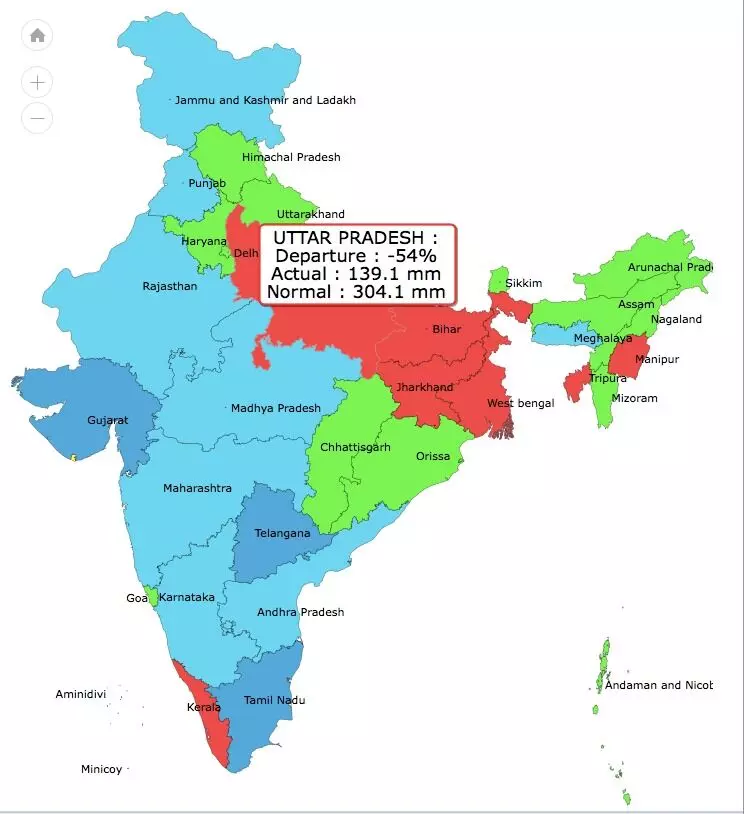
Note: Red colour denotes ‘deficient’ rainfall and yellow indicates ‘large deficient’ rainfall.
As per the India Meteorological Department (IMD), so far in this southwest monsoon season from June 1 to July 25, Panna district has a rainfall deficit of minus 21 per cent. In the neighbouring districts of Satna and Rewa, the rainfall deficit stands at minus 34 per cent and minus 43 per cent. The highest rainfall departure in Madhya Pradesh is in Sidhi district at minus 51 per cent.
Map: Districtwise rainfall in Madhya Pradesh (June 1 to July 25, 2022).
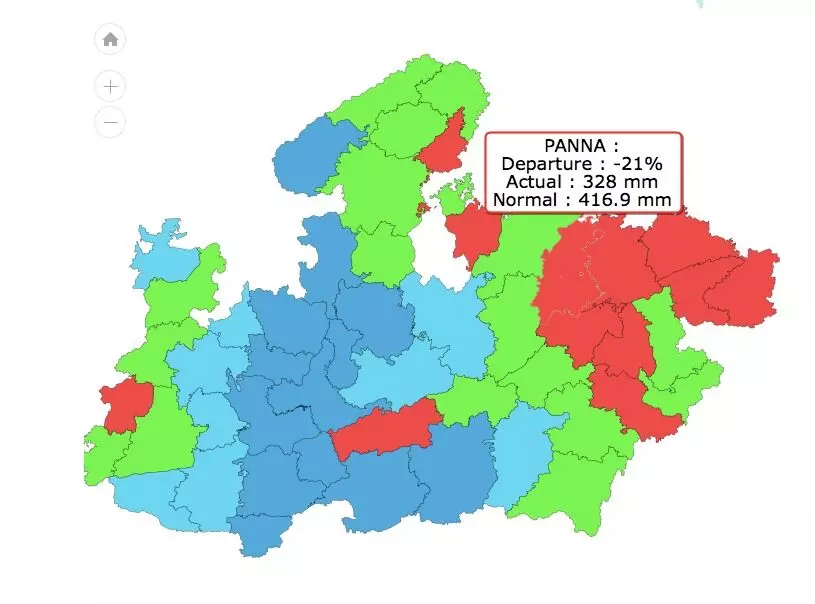
Note: Red colour denotes ‘deficient’ rainfall and yellow indicates ‘large deficient’ rainfall.
However, Madhya Pradesh state has overall received an excess rainfall of 23 per cent.
Situation is grim in the neighbouring state of Uttar Pradesh, which has registered a deficient rainfall of minus 54 per cent, the highest in the country. Bihar, Jharkhand and West Bengal have rainfall departures of minus 45 per cent, minus 49 per cent and minus 26 per cent, respectively.
Map: Districtwise rainfall in Uttar Pradesh (June 1 to July 25, 2022)
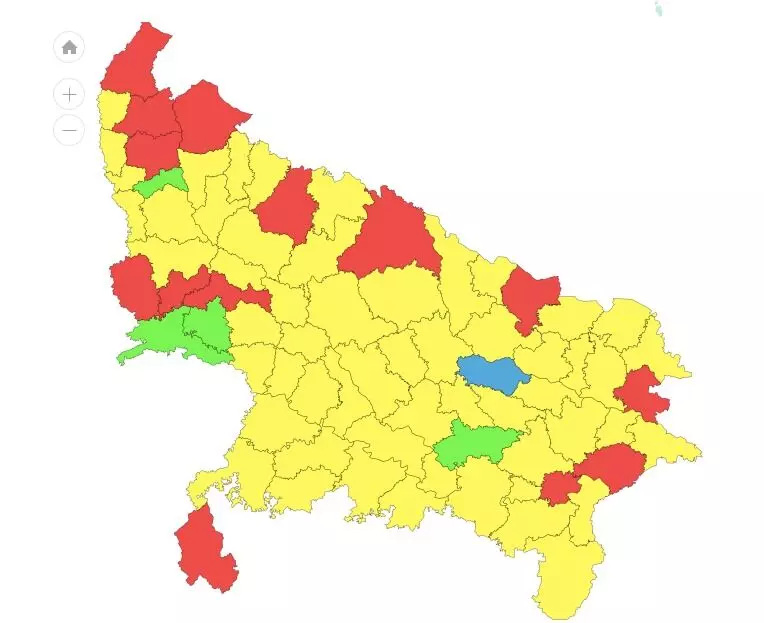
Note: Red colour denotes ‘deficient’ rainfall and yellow indicates ‘large deficient’ rainfall
“The situation is similar across Bundelkhand. The rainfall received so far is too low. Paddy is cultivated on almost 100,000 hectares of land in Panna alone. Next to paddy, farmers here grow pulses and til [sesame] but even those crops are not doing well this year,” PN Tripathi, senior agricultural scientist at the Krishi Vigyan Kendra (farm science centre) in Panna, infomed Gaon Connection.
In Uttar Pradesh’s Lalitpur district, which forms a part of the Bundelkhand region, the acreage of paddy is on a decline, as reflected in the state’s Department of Agriculture data.
As per the official data accessed by Gaon Connection, opposed to the target sown area of 309,078 hectares last year (FY 2021-22), only 300,285 hectares was harvested.
Also, so far this year, 239,132 hectares of the acreage out of the target acreage of 335,405 hectares of land has been sown in the kharif season but adverse weather conditions have discouraged the hopes of farmers sowing both paddy and pulses.
Pulses crop affected too
Apart from paddy, even farmers growing pulses in Bundelkhand have been affected due to low rainfall this monsoon season.
Tripathi, the agricultural scientist, informed Gaon Connection that the state’s Farmer Welfare and Agricultural Department has appealed to farmers to prefer sowing less water-intensive crops like pulses.
However, even cultivators sowing pulses in the district are reeling under the clout of losses.
“As opposed to paddy, pulses have a higher chance to reach the harvest stage as they require less water. But even these crops are on the verge of getting destroyed. It needs to rain as soon as possible. The situation is similar in other districts like Chattarpur, Tikamgarh, Satna, Rewa, and Singhrauli,” Gyanendra Tiwary, regional coordinator of Swayamsevi Sanstha Samarthan, an NGO that is promoting organic farming in more than 24 villages in Panna district, told Gaon Connection.
According to him, farmers who have cultivated pulses like urad [black gram], moong [green gram] and arhar [pigeon pea] are affected by drought-like conditions.
Bundelkhand is amongst the most drought prone regions in India. As per a research study published by the National Institute of Disaster Management in 2014, for most part of the year, residents of Bundelkhand experience acute scarcity of water for agricultural and domestic use.
“Most agriculture is of the single-crop variety and rain fed, with supplementary water from open wells. Thus, a large number of farmers are highly dependent on the monsoon rains to recharge these wells,” the research study titled Bundelkhand Drought Retrospective Analysis and Way Ahead noted.
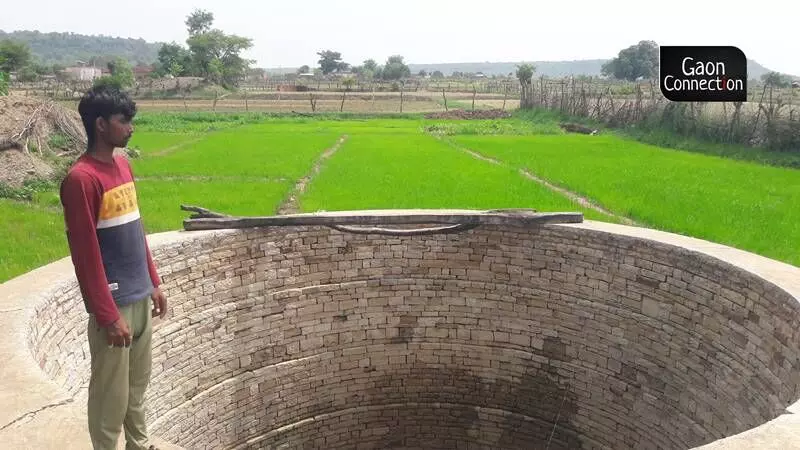
Most agriculture in Bundelkhand is of the single-crop variety and rain fed, with supplementary water from open wells.
As part of its recommendations to mitigate the effects of drought in Bundelkhand, the study noted that despite recurring drought as a chronic problem of Bundelkhand region, the focus has been only on alternative employment as relief, drinking water and agriculture promotion through irrigation to some extent.
“Whereas there has been very less emphasis on promotion of dryland agriculture and reclamation of wastelands in the region. Dryland agriculture holds the key to departure from dependence on rain and rain-fed systems,” the 2014 study stated.
Promote indigenous varieties of paddy
According to Padma Shri Babulal Dahiya, who has conserved almost 200 indigenous varieties of paddy, the effect of low rainfall will be far less on the farmers who have sown the indigenous varieties of paddy.
“The modern, hybrid varieties of paddy are bound to suffer under the present weather conditions. In a geography like Bundelkhand, it is best to stick to traditional varieties of paddy,” he said.
The paddy expert pointed out that the indigenous varieties of paddy can sustain even with the atmospheric humidity whereas the hybrid varieties need high rainfall and irrigation for them to reap a successful harvest.
With inputs from Arvind Singh Parmar in Lalitpur (Uttar Pradesh).




















